We have seen a lot of such beautiful paintings as we willingly followed the fascinating history of the magic mythos of Egypt. And we might have never thought about how they have been made. In ancient Egypt, some true original artisans did practise these magnificent arts in their artisanship. They were experts and aware of their incredible skills.
Of course, these treasures did not remain intact, so the artisans of our times had to reconstruct them; we could call them all: Their “own” dwellings of eternity!
Here we read an article about a part of this operation with great thanks to Marie Grillot in companion with Ayman Amer. 🙏
via égyptophile
Pharaoh’s craftsmen and their “own” dwellings of eternity: Minister Khaled El-Enany inaugurates three new tombs in Deir el-Medina
On March 30, 2016, during his first visit to the west bank of Luxor as Minister of Antiquities, Khaled el-Enany came to Deir el-Medina to see the progress of the restoration and development of three tombs to be opened to the public.
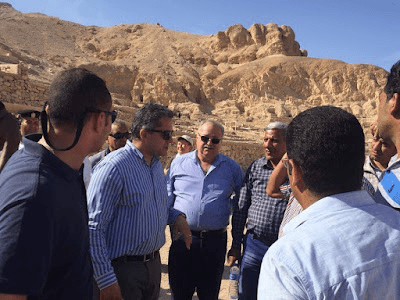
The Minister stayed on the site for more than an hour – Photo Ayman Amer.
The Antiquities Department has carried out the final fittings and fittings needed to welcome visitors; the Minister was able to proceed, on May 13, with their official inauguration. He was accompanied by many personalities, including Dr Mahmoud Afify, head of the Egyptian Antiquities Sector, Mostafa al Saghir, chief inspector of Antiquities on the west bank of Louqsor, … but also two officials from the Louvre museum, Jean- Luc Martinez, president and director, and Vincent Rondot, from the Department of Egyptian Antiquities.
In his speech, he specified that the restoration of the tombs of Deir El-Medina was implemented with the collaboration of the French Institute of Oriental Studies (IFAO). He also pointed out that: “The opening of these tombs is part of the efforts of the Ministry of Antiquities to protect the heritage of Egypt and to open new archaeological sites to promote tourism”.
And, it is under a crushing sun that he has, in a certain way, given new life to the dwellings of the eternity of three servants of the “Place of Truth”.
In antiquity, Deir el-Medineh was called Set Maât (the “Place of Truth”): the craftsmen lived who worked on digging and decorating the eternal abodes of the Valley of the Kings the Valley of the Queens. In his Necropolis, so far, only four tombs have been opened: Sennedjem (TT 1), Inerkhau (TT 359), Pached (TT 3) and Irinefer (TT 290).
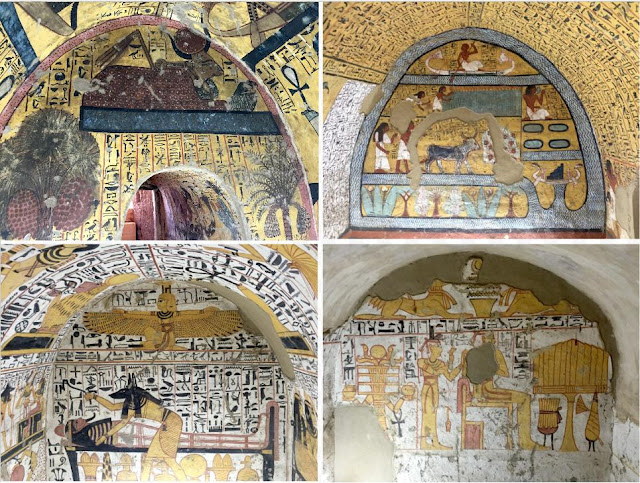
en bas à g. : TT 219 – Nebenmaat
en bas à dr. : TT 220 – Khaemter photos © Ayman Amer (IFAO)
It is now possible to visit TT 218 – tomb of Amennakh, TT 219 – tomb of Nebenmaat and TT 220 – tomb of Khaemter. Located in the western Necropolis and found by Bernard Bruyère in 1928, they date from the 19th dynasty, the reign of Ramses II). Contiguous, they belong to members of the same family: “Amennakht, his son Nebenmaât and his grandson Khaemter thus have three vaults benefiting from common areas and three adjoining surface chapels (TT 218-219-220).” (osirisnet.net)

TT 218 – photo by the Ministry of Antiquities
The tomb of Amennakht – TT 218 – “servant of the Place de Vérité” has 2 vaults. It is of the “polychrome” type, and its rich iconography has retained its beautiful colours. There are stunning scenes mainly of adoration, offerings or funeral rites. On one of the eardrums, the celestial cow ‘meh-urit’, also called ‘the eye of Re’, appears in the form of the goddess Hathor, the mistress of the Amanti, with a falcon in front of her. Below, on each side, scenes declined under a doum palm tree. On one side, the deceased, dressed in a pleated white loincloth, is kneeling under a very lavish palm tree, drinking blue water from a basin. Behind him, with her back to him, a woman, beautifully dressed in pleated white linen, adorned with a necklace and bracelets, stands with her arms raised in adoration. On the other side, two women with long curly brown hair are under a much more delicate, almost “feminine” palm tree; the deceased’s wife is kneeling while her daughter is standing in adoration. The vertical text bands are written in black and stand out against an ocher background.
Another exciting scene represents Osiris seated with a falcon behind him and the ‘udjat’ eye emerging from the Theban mountain carrying a brazier. Below, a very well composed scene brings together three members of the deceased’s family in adoration. And finally, a very touching scene where Anubis has his two hands resting on the mummy, sleeping on a mummification bed. She is protected at the feet by Isis and at the head level by Nephthys, who are represented in the form of two kites. “Why did you choose these birds of prey as an icon of the goddesses? Perhaps because their stridulations recall the oriental laments which, punctuated by shrill cries, were bound to accompany funeral wakes. Following the well-known Osirian myth, the sisters watch over the deceased, new Osiris, as they watch over their brother (and husband for one, lover for the other) dead Osiris. (Thierry Benderitter – osirisnet.net).
The tomb of Nebenmaât – TT 219 – combines a polychrome chapel with a monochrome vault and is thus the first of this type to be opened. Bernard Bruyère, the ‘great discoverer’ of Deir el-Medineh, defines this type of tomb as follows: Medineh, in which the silhouettes that adorn the walls are made in yellow ocher on a white background, while the use of black and red is restricted to the outline of the representations, to the internal detail of the figures and objects and the layout of the hieroglyphic inscriptions .” Its walls offer beautiful scenes. Among them is the ritual opening of the mouth, which is different from those found in other tombs in the village. Anubis is leaning over the mummy, which rests on a mummification bed. Under the layer are a series of exquisite vases and a: “mirror with a handle, symbol of Hathoric beauty, intended to stimulate the reproductive ardours of the deceased”. The text strips are black on a white background. The scene is surmounted by a beautiful kneeling goddess Isis, who extends her protective wings and whose waist is deliciously and doubly girded with a red ribbon whose sides fall to the ground.
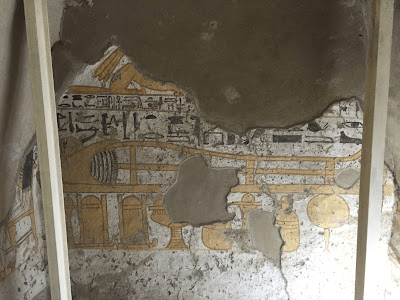
TT 220 – photo Ayman Amer
The tomb of Khaemter – TT 220 is monochrome and in less good condition, with particular significant gaps on the walls and the ceiling. On one of the eardrums, an exciting and perfectly symmetrical scene: two Anubis whose heads are partly missing, their necks surrounded by a cloth, face each other. In the centre, a pot surmounted by the three wavy lines standing for “Nun” (the primordial ocean from which the world came out), itself surmounted by the sign ‘shen’, the symbol of eternity. Below, occupying about a quarter of the wall is a curious Djed pillar. It is provided with two arms carrying vases which pour water while inside his elbow(s) a beautiful cross of life ‘ankh’ is hung. On the other part of the wall, the deceased (in Osiris) is seated, standing behind him, the goddess Isis. They are facing a table carrying food.
These three tombs offer us a new insight into the expression and sensitivity of the craftsmen – artists – of the Place de Vérité. No doubt they will delight the eyes of visitors… just as the tomb of Djehouty will not fail to do. (TT 110), opened that same day in the Necropolis of Sheikh Abd El-Gournah.
Marie Grillot & Ayman Amer (IFAO)
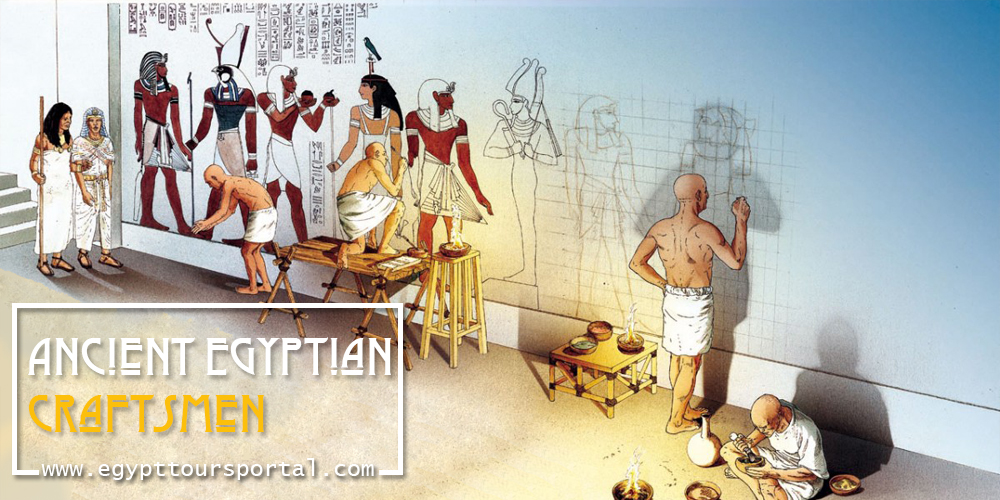
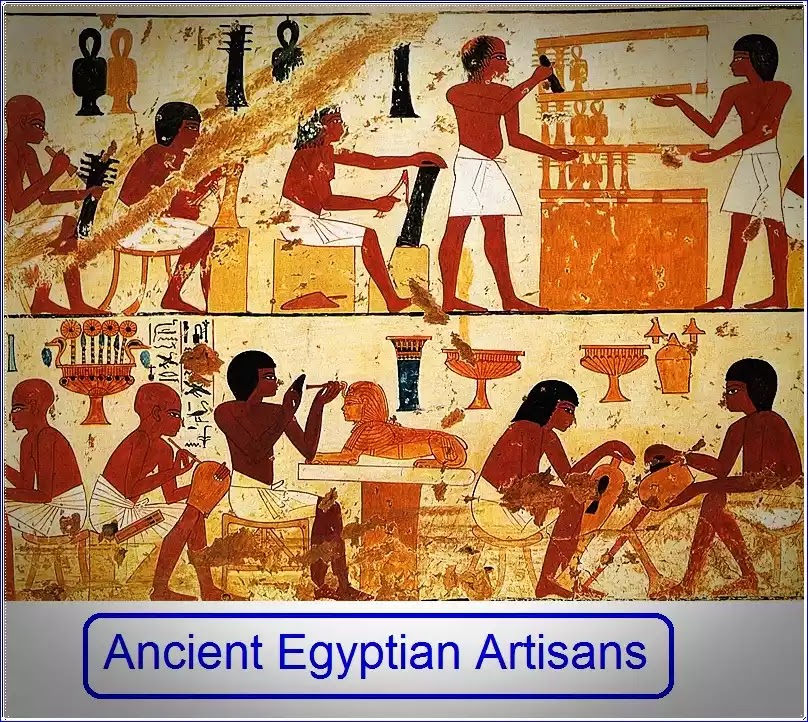



Fascinating! I love to go.
LikeLiked by 1 person
Take me with you! 😊Thank you, dear Chris. 🙏🤗💖
LikeLiked by 1 person
Off we go…✈️🚂🐪
LikeLiked by 1 person
It looks unlikely I’ll get to these tombs in this lifetime, but I love so much about Egyptian mythology and art. The combination of deep underground tombs and dry desert air preserved so much. Thanks for sharing this, Aladin.
LikeLiked by 1 person
Well said, dear Elaine. It’s a magic itself. Thank you for your kind words ❤️ 🙏
LikeLiked by 1 person
So beautiful
LikeLiked by 1 person
Indeed, thanks 🙏🤗
LikeLike